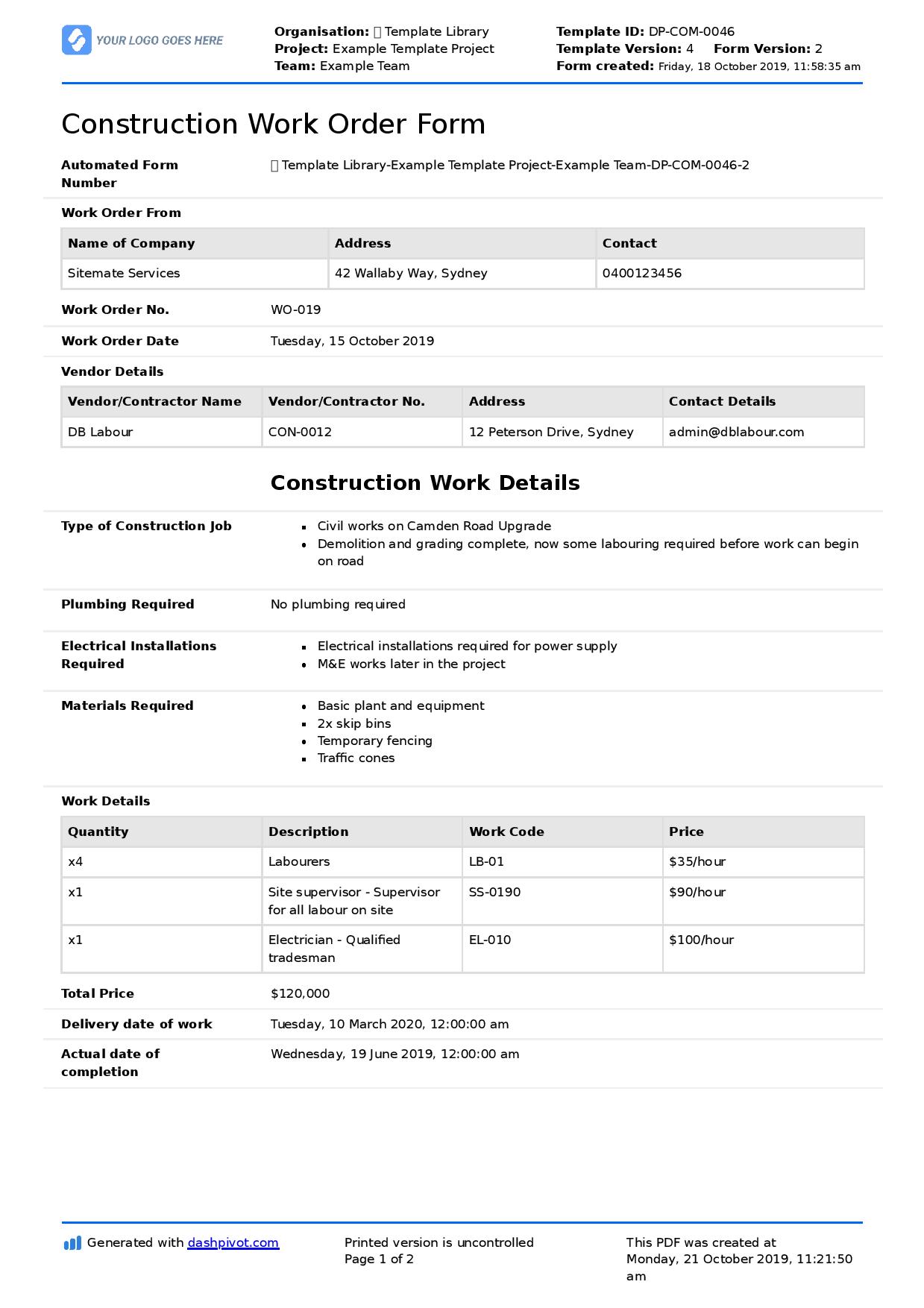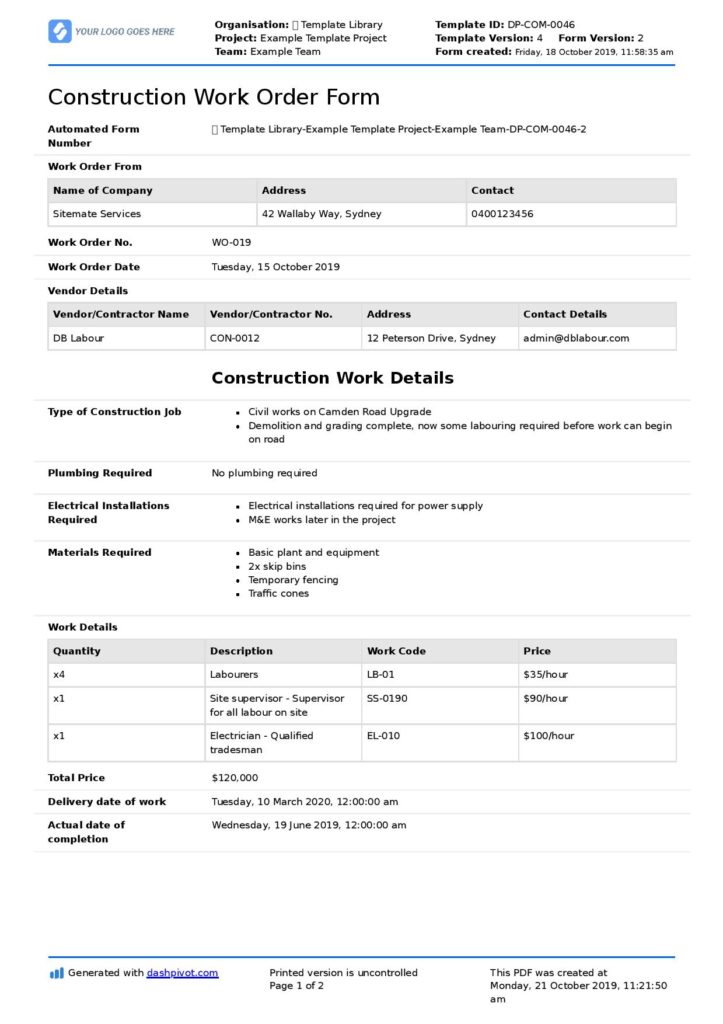Construction work order format
Construction work order format (Better than word, excel and PDF format)
In this article, we cover an ideal construction work order format whether you are using Word, Excel or PDF, and provide some more modern and streamlined approaches to documenting and managing work orders as well.

What is a construction work order?
A work order is a task or job for a customer which is schedule or assigned to someone. Not all tasks and jobs are assigned or defined as work orders, but many of them are.
And so a 'construction' work order is the same as the above, but applied to the construction industry or construction projects.
Because there are so many parties working and collaborating on construction projects, there are many opportunities for work orders to be issued. They may be issued to a subcontractor, specific service or even a product-based company.
Work orders can even be issued internally, with many large companies relying on work orders to move jobs and tasks between and across departments.
In the construction industry, it's common for work orders to be created following inspections and audits. These inspections and audits often surface something which needs to be rectified with a specific job or task - or 'work order'.
Construction work orders can be linked to bills of materials and be used as invoices, depending on the normal practices of a particular contractor or company and the nature of the work order or projects.
What we care most about for the sake of this article is your construction work order format. The format you choose and use for your work orders can have significant impact on the outcome of your work orders and work in general.
In fact, the format of your work orders on construction projects might just be one of the most overlooked piece of documentation, which many companies are 'paying for' in delays, lost productivity and poor communication.
What's wrong with a work order format in word or excel or PDF?
The most common formats for work orders in construction are word, excel and PDF. These formats are formats which have been used and relied on since the advent and adoption of computers as a means to manage work and documentation.
While there was nothing wrong with using word, excel and PDFs for work orders in the past; today, it's an outdated means of managing work orders.
Newer and more modern approaches to work orders aren't just 'better', they improve how work orders are sent and received, signed off and shared, stored and found in the events of disputes and more.
What are some of the problems with word, excel and PDF formats for work orders?
- You have to constantly format and reconcile work orders from word docs to PDFs to excel sheets. Maybe you create your work order template in word, download it and share it as a PDF and reconcile your work order records in excel
- These work order formats need to be constantly emailed, talked about over the phone etc.
- There are multiple versions and revisions of each construction work order floating around, with no way to know the exact source of truth
- Different people use different work order frameworks and templates which results in unstandardised data and missing key information
- Work orders are often used to discuss and dispute specific jobs or tasks, and many companies can't find or pull up their work orders because they are buried on hard drives and in folders
These are just a few of the issues associated with word, excel and PDF work order formats.
Anyone who has used these formats for their construction work orders have usually experienced the inefficiencies and inadequacies of these systems.
So what is a better construction work order format then?
The better construction work order format
The best construction work order format for your work orders today are software-based work orders. Work order and digital document management systems enable companies to digitise and streamline how they create, organise and track their work orders in a single system.
We'll dive into the details of these work order formats below, but in a nutshell, a digital work order format enables a company to streamline how they create, capture, organise and track work orders:
Create - In this format, construction work orders can be chosen from a free library or created from scratch with a drag and drop builder with no need to space formatting and other tinkering.
Capture - Work orders can be filled out directly on construction sites using a mobile or tablet, or filled out on a computer just like in word or excel.
Organise - A modern construction work order format enables real-time syncing, which means that every time a work order is created or signed off, it is instantly synced and sent to a central system. These systems can also automatically organise this type of information into specific projects and teams, so that every work order goes to the right place at the time of creation.
Track - Because all work orders are sent to a central system, tracking them is easy. People can see exactly when a work order was created or signed off, updated, download and can also see exactly where a work order is in the process - whether it's held up by the other party etc.
In terms of the actual 'format' of the work order, most work orders come with a few key sections:
- A description of the project, job or task
- Details on the companies/vendors involved
- Instructions about that job or task
- Cost estimates for this work order
- The date and time to execute the order
- The person or people who the work order is assigned to
As you can see from the below construction work order format, most good frameworks include most or all of these details, with most framework differing slightly based on the company, project etc.
A digital system for managing construction work orders allows a company to customise the exact questions and format of the work order using things like drag-and-drop functionality and smart fields.
So you have all of the power and flexibility of formats like word docs, excel and PDFs - but without the manual work and messiness involved with managing information in these formats.

Use this smart work order format for yourself for free.
How to really streamline your work orders (and other similar processes)
Digitising your construction work order format can have a big impact on the quality of your records and the efficiency of workers. But there is more to the smart systems which help companies better manage construction work orders.
It's not just about having an easier and more accessible format than word, excel and PDF - it's about changing the mechanisms by which work orders move.
Firstly, it's about making work orders more accessible. Before digital systems, word docs, PDFs and excel sheets were only available to some people, and many of the available documents were the wrong or outdated versions.
Secondly, the right construction work order format can enable automation. Powerful workflows enable companies to automate how work orders move between companies and workers - especially internally.
Repetitive construction work orders can become part of an automated flow. For example, when someone in a specific department issues a work order, someone in the responsible or actioning department gets an instant notification. They can open the exact same work order, fill out their section and complete the work, and then sign and close it off.
This one simple workflow can eliminate multiple emails and a bunch of back and forth, not to mention having to download the word doc or PDF each time.
Some construction companies send and manage thousands of work orders, and each work order takes time, as well as introduces risk associated with work not getting done, work getting delayed and more.
By better managing work orders through work order software, contractors and other construction and other industrial companies can dramatically improve how they communicate and manage work orders - which instantly improves how work gets done.
These same principles can be applied to many other types of processes and procedures, many of which bounce back and forth between parties and need to be properly documented and signed off - including defect management, delivery dockets and more.

Construction work order
Use and adapt this form template for any type of work order

Meeting Minutes template
Capture, record and organise those meeting minutes.

Work order request
Streamline and automate work order requests for all parties

